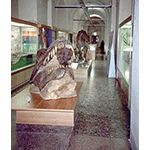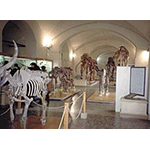Museo di Storia Naturale di Firenze - Sezione di Geologia e Paleontologia [Florence Museum of Natural History - Geology and Palaeontology Section]
The palaeontology collections, begun already in the 16th century by the Medici and placed among the works of art in the Galleries of Palazzo Pitti and the Uffizi, was further enriched by the Lorraine family, when a specific section was created in the great Museum of Physics and Natural History.
In 1870, subsequent to the establishing of the Institute of Higher Studies, the collections were moved to the "Geology Cabinet" in Piazza San Marco. Lastly, in 1925, they were transferred to their present location in Via La Pira. The Museum's heritage has been progressively incremented, both through the purchase of the collections of Pier Antonio Micheli, Giovanni Targioni Tozzetti (in 1845) and Strozzi (in 1895) and thanks to objects collected in numerous voyages of exploration and study. Today, in addition to its educational and research function, the Section carries out salvaging and restoration initiatives.
The museum has four main collections. The collection of Invertebrates (around 175,000 samples) contains specimens from the Palaeozoic era, of both Italian and foreign provenance. Particularly rich is the collection of Pliocene molluscs from Tuscany donated by the Dalmine Company. Of notable interest are the Fucini, De Stefani, Dainelli and Marinelli, Stefanini, and Seguenza collections.
The collection of fossil plants (around 8,000 samples) contains samples coming mainly from Tuscany. The collection of phyllites from Monte Pisano, the Strozzi collection, and the collection of plant remains from the Santa Barbara mine (early Villafranchian period) are especially important.
The rock collection (about 5,000 specimens) is composed of a generic rock collection, of rocks coming from Eritrea, Ethiopia, Somalia, Tibet, and Caracorum, and of rocks collected along the Sempione and San Gottardo tunnels.
Lastly, the collection of Vertebrates (around 27,000 specimens), originating from the Medicean and Lorraine collections, contains mainly fossilised remains of mammals from the Villafranchian period (Plio-Pleistocene) coming from the Upper Valdarno area, for which the Museum holds a place of national and international importance. In addition to Italian Vertebrates, there are remains coming from various places (New Zealand, North America, India, and Siberia). There are also numerous assembled skeletons (elephants, rhinoceros, hippopotamus, leptobos horses and others). Noteworthy among these is an almost complete skeleton of the Oreopithecus bambolii (anthropoid monkey).
****************************
Texts by Graziano Magrini
English translation by Catherine Frost
Last update 26/gen/2008





